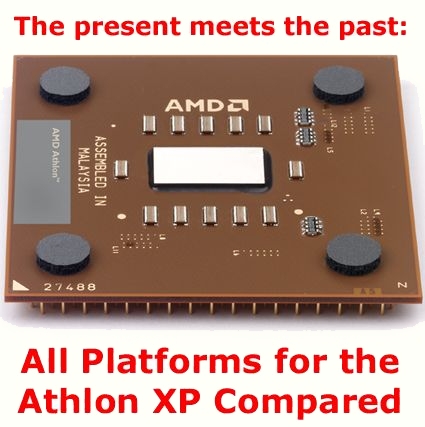Then and Now: Athlon Platforms Compared
Athlon Platform History: Sockel A, Then And Now
It's a success story like no other. After four years of competition between Intel and AMD, the small Texas-based chip manufacturer was able to cast a shadow of doubt on Intel's dominance with its own Athlon processor. And this has been the case till now.
In those days, fast versions of the Athlon, Slot A versions followed each other in quick succession. 700, 800, 900 MHz - and, as a matter of fact, Intel reached the magic 1 GHz number only shortly after AMD. What a disgrace for the market leader! To make matters worse, AMD attained its goal with a CPU that was based on an external cache unit. Intel, by contrast, launched the Pentium III Coppermine at an early date and initially integrated the L2 cache on the die.
The pressure on Intel was so immense that a Pentium III with 1.13 GHz was hastily introduced to the market. This processor had only one purpose: to win back the performance crown. At the time, Tom's Hardware played an important role in revealing processing errors in the 1.13 GHz model; and, as a result, this model was quickly recalled.
From then on, Intel began concentrating on the Pentium 4, which was to keep the Athlon in its place with higher clock speeds. As a reaction to this increase in clock speed, AMD could only counter by giving its Athlon XP (Palomino core) a "P" rating, as was already known in the days of the 486. An Athlon XP 2000+, for example, can run about as fast as a Pentium 4 with 2 GHz, but it only requires 1.66 GHz.
In order to close in on the 2 GHz limit and keep up with the Pentium 4 models, AMD developed the Thoroughbred core with 0.13 micron. However, it was soon updated with the Thoroughbred B, which acts as the basis for today's Athlon XP models over 2200+, and which increased the FSB from 266 to 333 MHz.
Today, the Barton processors are on the shelves. What it has to offer is 512 kB of integrated cache. Together with fast platforms (NVIDIA nForce2, VIA KT400A), AMD can once again increase the performance level and continue to make life uncomfortable for Intel.
Get Tom's Hardware's best news and in-depth reviews, straight to your inbox.
Current page: Athlon Platform History: Sockel A, Then And Now
Next Page Often Overlooked: The Platform
Patrick Schmid was the editor-in-chief for Tom's Hardware from 2005 to 2006. He wrote numerous articles on a wide range of hardware topics, including storage, CPUs, and system builds.
